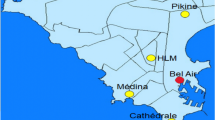Abstract
Understanding the changes in the air pollution of an area due to implementation of control strategies is important as it helps in making further action plans. Time series analysis provides ways to interpret the effect of any policy changes. In this study, the applicability of the CUSUM method for change detection in air pollutant concentrations in Delhi is investigated. The method detects any shift from mean of the process. Delhi has undergone major policy changes during the past few years. Change of fuel in vehicles to compressed natural gas (CNG) is one amongst them. The data observed at a traffic site in Delhi for nitrogen dioxide (NO2), carbon monoxide (CO) and particulate matter (with size less than 10 micron-PM10) concentrations is used to carry out the analysis. Increase in NO2 concentration and decrease in CO concentration levels is observed using CUSUM method. The choice of base period does not affect much for these two pollutants but for PM10 concentration, however its role is crucial. In order to counter any variability shifts, the CUSUM method is further modified to account for the change in the variance of the time series. Modified CUSUM method indicated similar nature of variability in NO2 and PM10, whereas CO variability has decreased significantly after CNG implementation.





Similar content being viewed by others
References
Aneja VP, Agarwal A, Roelle PA, Philips SB, Tong Q, Watkins N, Yablonsky R (2001) Measurement and analysis of criteria pollutants in New Delhi, India. Environ Int 27:35–42
Barratt B, Atkinson R, Anderson HR, Beevers S, Kelly F, Mudway I, Wilkinson P (2007) Investigation into the use of the CUSUM technique in identifying changes in mean air pollution levels following introduction of a traffic management scheme. Atmos Environ 41:1784–1791
Carslaw DC, Ropkins K, Bell MC (2006) Change-point detection of gaseous and particulate traffic-related pollutants at a roadside location. Environ Sci Technol 40:6912–6918
Chelani AB, Devotta S (2007) Air quality assessment in Delhi: before and after CNG as fuel. Environ Monit Assess 125:257–263
Chetouani Y (2008) A neural network approach for the real-time detection of faults. Stoch Environ Res Risk Assess 22:339–349
Dondero L, Goldemberg J (2005) Environmental implications of converting light gas vehicles: the Brazilian experience. Energy Policy 33:1703–1708
Goyal P, Sidhartha (2003) Present scenario of air quality in Delhi: a case study of CNG implementation. Atmos Environ 37:5423–5431
Gulati AR (2001) Director transport engineering. Bureau of Indian Standards, Delhi
Gurjar BR, Aardennea JA, Lelievelda J, Mohanb M (2004) Emission estimates and trends (1990–2000) for mega city Delhi and implications. Atmos Environ 38:5663–5681
Kandlikar M (2007) Air pollution at a hotspot location in Delhi: detecting trends, seasonal cycles and oscillations. Atmos Environ 41:5934–5947
Kathuria V (2004) Impact of CNG on vehicular pollution in Delhi: a note. Transport Res D 9(5):409–417
Lucas JM (1982) Combined Shewhart-CUSUM quality control scheme. J Qual Contr 14:51–59
Moreno E, George C, Garcia-Ferrer A (2005) An objective Bayesian analysis of the change point problem. Stoch Environ Res Risk Assess 19:191–204
Narain U, Krupnick A (2007) The impact of Delhi’s CNG program on air quality. Resources for the Future. Washington, DC. http://www.rff.org/Publications/Pages/PublicationDetails.aspx?publicationID=17476
Page ES (1954) Continuous inspection scheme. Biometrika 41:100–115
Yadav S, Rajamani V (2006) Air quality and trace metal chemistry of different size fractions of aerosols in N–NW India—implications for source diversity. Atmos Environ 40:698–712
Yeh S (2007) An empirical analysis on the adoption of alternative fuel vehicles: the case of natural gas vehicles. Energy Policy 35(11):5865–5875
Acknowledgments
Author is thankful to anonymous reviewers for constructive comments which helped improve the manuscript.
Author information
Authors and Affiliations
Corresponding author
Rights and permissions
About this article
Cite this article
Chelani, A.B. Change detection using CUSUM and modified CUSUM method in air pollutant concentrations at traffic site in Delhi. Stoch Environ Res Risk Assess 25, 827–834 (2011). https://doi.org/10.1007/s00477-010-0452-6
Published:
Issue Date:
DOI: https://doi.org/10.1007/s00477-010-0452-6




